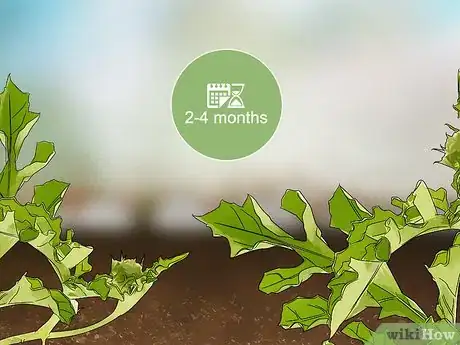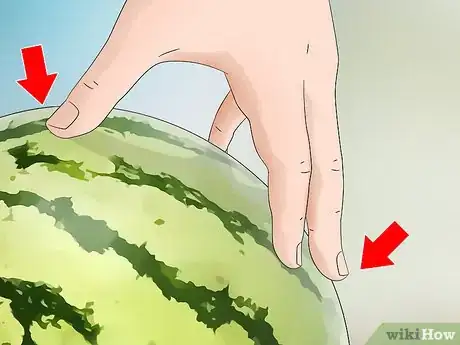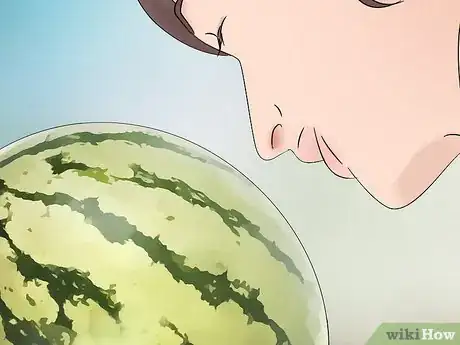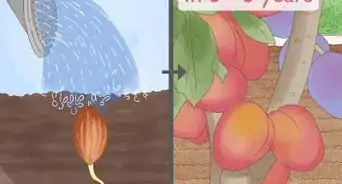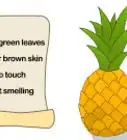This article was co-authored by wikiHow Staff. Our trained team of editors and researchers validate articles for accuracy and comprehensiveness. wikiHow's Content Management Team carefully monitors the work from our editorial staff to ensure that each article is backed by trusted research and meets our high quality standards.
This article has been viewed 14,479 times.
Learn more...
There's no summertime treat that quite matches the fresh sweetness of a watermelon picked from your own garden. While knowing how to grow your own watermelons is its own task, your efforts might go unrewarded if you don't know when to pick them. By knowing what to look for, feel for, and even smell for in a ripe watermelon, you'll be able to easily tell when your melons are ripe and ready.
Steps
Watching Your Melons Grow
-
1Let the watermelon grow for 2-4 months. There are a lot of different factors which will determine how long it takes for your melons to ripen, but it should be somewhere between 2 to 4 months. Look at the seed packet for the watermelons you're planting for an approximation of how long it'll take for them to ripen.[1]
- Write the date you planted your seeds on the seed packet and store it in a safe place. That way you can always keep track of exactly when your watermelons will be ready.
- The time it takes for your melons to ripen can vary based on the type of watermelon, the climate you're growing them in, and the type of soil, among other things. Don't rely on the expected time frame to tell when your watermelons will be ripe.[2]
-
2Check the color on the belly of the watermelon. Lift the watermelon up and turn it over, being careful not to pull it off the vine. Look at the “field spot” of the melon, where it has been resting on the ground as it grows. A buttery yellow color is a good indicator that the watermelon is ripe, whereas a white field spot means that it needs more time.[3]
- As you turn the watermelon over, look for and remove any insects hiding on its underside.
Advertisement -
3Examine the tendrils around the melon for browning. While the vines the watermelon grow off of will remain green up until they start to die, some of the tendrils around each melon may start to brown as the melon ripens. Look for this around each melon to help determine which ones are ready to be picked.
- If the whole vine starts to turn brown while there are still watermelons left on it, harvest them immediately. This indicates that the vine is dying, and the watermelons are as ripe as they'll ever be.[4]
Testing Your Watermelon
-
1Listen for a hollow sound when the melon is hit. Hold the watermelon up to your ear and knock on it with your knuckles or flick with one finger. A ripe watermelon will give off a lower-pitched and more hollow sound, whereas an unripe one will have a higher pitch to it. This can take some practice but is one of the more reliable ways to check for ripeness.[5]
- If you're unsure if your melon is making the right sound, find someone who can demonstrate it for you on a melon they know to be right. Ask around or check online to find out what the perfect melon should sound like.[6]
- Use your phone or another device to record the sound of a melon you think is ripe. If it's perfect when you cut into it, you can keep that recording to test the sound of other melons from the same and future crops.
-
2Squeeze the watermelon to test its give. A ripe watermelon should have a little give to it when firmly squeezed. Use two hands to give the watermelon a light squeeze to check its give, being careful not to damage the melon in the process.[7]
-
3Look for a dull color over a bright shine. As watermelons mature, they will shift from having a bright green rind with a slight shine to a duller and more uniform tone over the top. Look for melons without a shine and with very little contrast between its stripes.
-
4Check for a slightly sweet smell. While more difficult to detect than most other methods, the smell of a watermelon can help indicate when it is ripe and ready to pick. Get close up to the watermelon and inhale deeply. A ripe melon should have a sweet scent to it, and remind you of the flavor of a perfectly ripe watermelon.[8]
- If you're growing a lot of watermelons, this test might become less effective. It's much more difficult to pick out the smell of 1 watermelon from a field of them than it would be testing one on its own.
- While it works on watermelons, the smell test is even more effective with other types of melon.
References
- ↑ https://www.treehugger.com/green-food/how-tell-if-watermelon-ripe.html
- ↑ https://www.almanac.com/plant/watermelons
- ↑ https://www.treehugger.com/green-food/how-tell-if-watermelon-ripe.html
- ↑ https://www.treehugger.com/green-food/how-tell-if-watermelon-ripe.html
- ↑ https://www.huffingtonpost.com/entry/is-that-watermelon-ripe_us_575abba5e4b0ced23ca7c367
- ↑ https://www.treehugger.com/green-food/how-tell-if-watermelon-ripe.html
- ↑ https://www.almanac.com/plant/watermelons
- ↑ https://www.treehugger.com/green-food/how-tell-if-watermelon-ripe.html
- ↑ https://www.almanac.com/plant/watermelons
